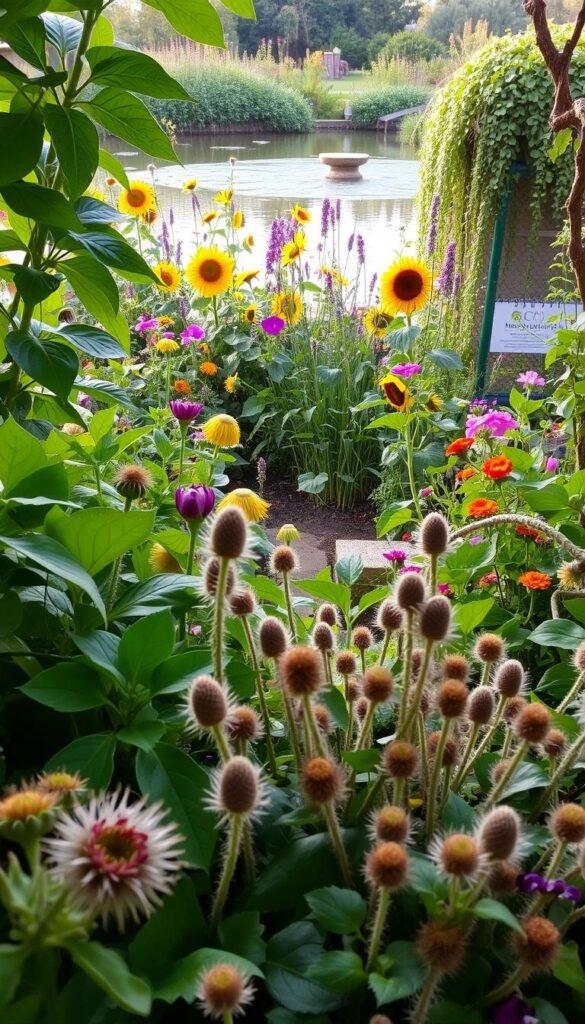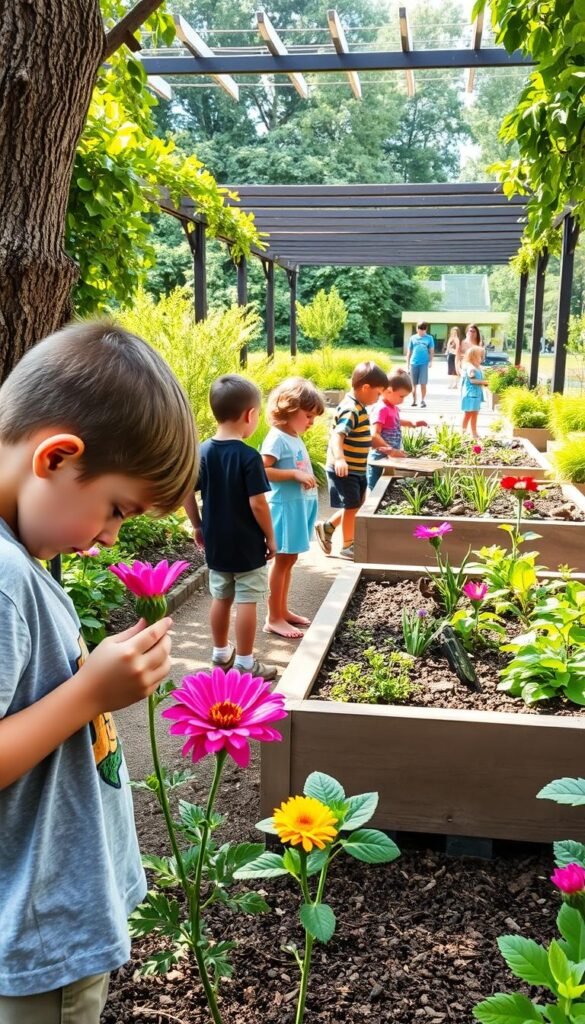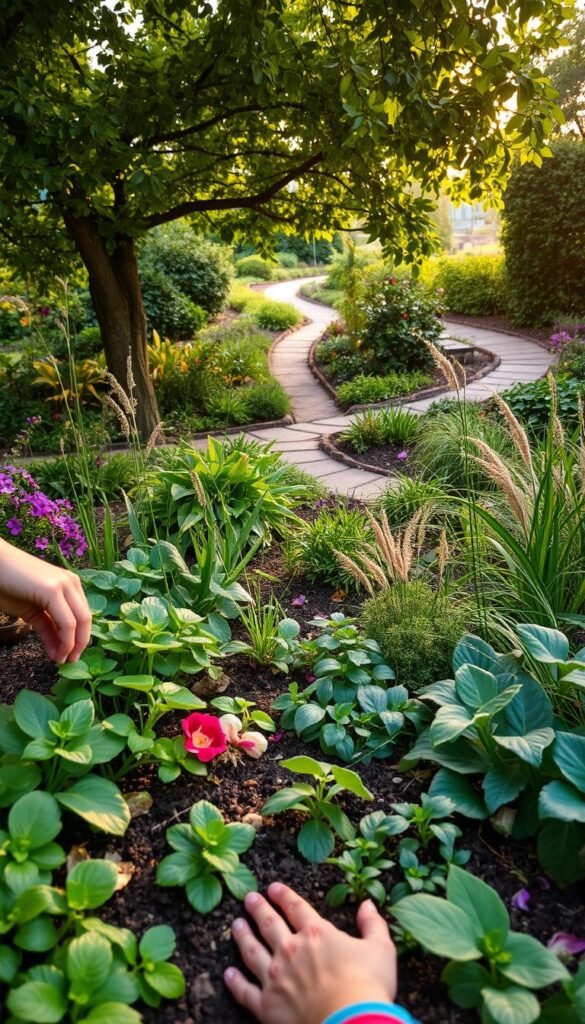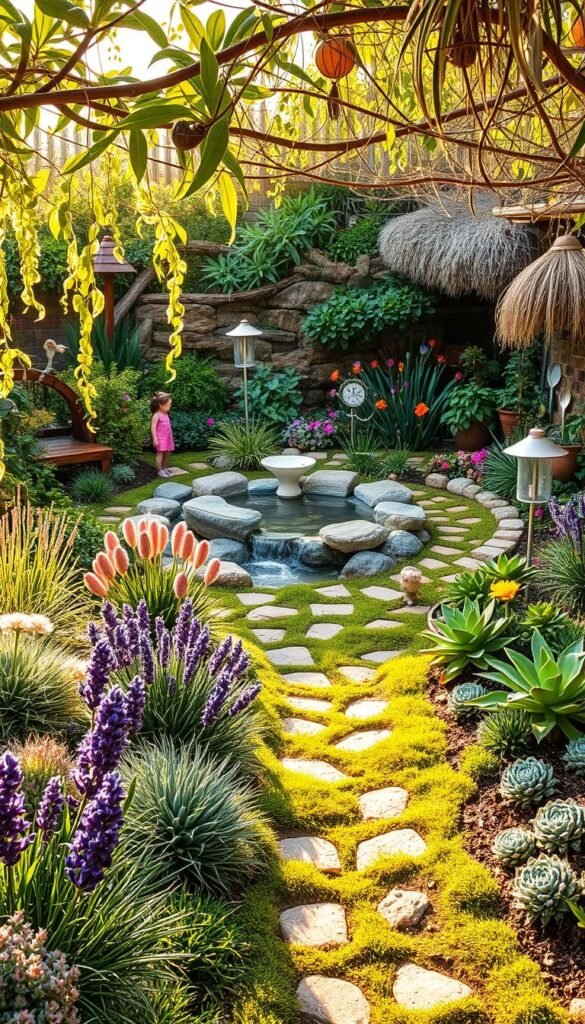Imagine a place where rustling leaves become music, fuzzy lamb’s ear plants tickle fingertips, and bursts of lavender scent dance in the breeze. This is the magic of a sensory garden – a living playground designed to spark curiosity and connection with nature. These spaces turn ordinary yards into wonderlands that invite children to explore textures, colors, and sounds.
What makes these gardens special? They’re built to engage every sense. Think about crunchy gravel paths underfoot, wind chimes whispering secrets, or sunflowers stretching toward the sky. Each element invites discovery while nurturing emotional growth and creativity. Even simple features like textured stepping stones or scented herbs can transform a basic garden into a dynamic learning environment.
Safety and accessibility matter too. Wide pathways let little explorers move freely, while sturdy plants withstand enthusiastic touches. Including interactive elements like water features or mirrored decorations adds layers of excitement. The goal? To create an environment where kids feel empowered to interact with nature on their terms.
Ready to unlock the full potential of your outdoor space? Let’s dive into creative ways to design a sensory-rich haven that grows with your child’s imagination.
Exploring the Five Senses in Your Sensory Garden

Picture your child laughing as wind chimes sing in the breeze and velvety petals brush their palms. A well-planned garden becomes a symphony of experiences, awakening curiosity through colors, textures, and sounds. By designing spaces that engage every sense, you create a living classroom where discovery feels like play.
Awakening Curiosity Through Nature’s Palette
Bright marigolds and towering sunflowers catch the eye, while rustling ornamental grasses add rhythm to the air. Crunchy gravel paths underfoot contrast with spongy moss patches, inviting little hands to explore. Aromatic herbs like mint or lemon balm release fresh scents when brushed, and edible nasturtium flowers offer a peppery surprise on the tongue.
Nurturing Hearts and Minds
These multi-sensory moments do more than entertain—they build emotional bonds with the natural world. Gentle water features soothe restless minds, while textured bark or smooth stones spark conversations about differences. Accessible areas let kids investigate freely, turning simple interactions into lasting memories of wonder.
Ready to make your space both safe and irresistible? Let’s explore how thoughtful design ensures everyone can join the adventure.
Designing for Safety and Accessibility

A truly welcoming garden feels like an open invitation—wide enough for wheelchairs and strollers, sturdy enough for curious hands. Start by mapping out paths at least 4 feet wide with smooth surfaces like packed gravel or rubber mulch. Gentle slopes (no steeper than 1:12) ensure everyone can explore independently.
Accessible Pathways and Garden Layout
Keep plants at arm’s level by retaining lower branches on shrubs like lavender or rosemary. Prune thorny varieties away from walkways, and use raised beds for easy touching. Tools like the Access Chain framework help spot barriers—like uneven steps or narrow turns—before they become problems.
Choosing Child-Friendly and Durable Materials
Opt for non-toxic plants like lamb’s ear or snapdragons that thrive with frequent handling. Surfaces matter too: rubber stepping stones cushion falls, while textured tiles spark sensory curiosity. Secure benches with rounded edges offer rest spots without sharp corners.
| Material | Best For | Safety Perks |
|---|---|---|
| Rubber Mulch | Play Areas | Soft, slip-resistant |
| Smooth Pavers | Main Paths | Stable, wheelchair-friendly |
| Crushed Gravel | Secondary Trails | Auditory feedback |
By blending smart design with tough materials, you create a space where discovery flourishes. Every choice—from plant placement to path width—builds confidence in young explorers.
Creative Sensory Elements and Interactive Features

Transform your outdoor area into a living laboratory where every corner invites hands-on discovery. Interactive elements turn ordinary spaces into dynamic zones that engage sight, sound, and touch while sparking imaginative play.
Harmony in Motion: Sound and Water
Bamboo wind chimes add gentle melodies that shift with the breeze, teaching kids about cause and effect. A shallow stream bed lets little fingers redirect water flow using rocks or PVC pipes—perfect for hot days. Pair these with crunching gravel paths to create a symphony underfoot.
Art That Invites Interaction
Local artists can craft weatherproof sculptures with spinning wheels or textured mosaics. Think polished stone tiles cool to the touch or cedar panels etched with animal tracks. These installations become focal points that blend art with sensory exploration.
| Element | Engaged Senses | Durability Tips |
|---|---|---|
| Copper Rain Chains | Sound, Sight | Use UV-resistant coatings |
| Sandstone Carvings | Touch, Sight | Seal against moss growth |
| Interactive Fountains | Sound, Touch | Child-safe pump systems |
Balance creativity with practicality by choosing materials that withstand enthusiastic exploration. The sensory garden design principles emphasize using contrasting textures like smooth river stones beside prickly pinecones. This variety keeps young minds curious across seasons.
Remember: the best features invite repeat visits. A bubbling rock fountain in summer might become an ice sculpture canvas in winter, revealing nature’s ever-changing rhythm.
5 Sensory Garden Ideas for Young Explorers

Unearth a world of wonder with plants that beg to be touched, tasted, and investigated. From tart Lemon Sorrel leaves to grape-sized Cucamelons, these living puzzles turn your outdoor space into a classroom without walls. Kids learn best when their entire body engages—crunching edible flowers or unraveling papery husk cherries like nature’s origami.
Edible Adventures and Tactile Treasures
Lemon Sorrel’s zesty leaves offer instant taste-test surprises, while Cucamelon vines produce mini watermelon lookalikes perfect for tiny hands. Husk cherries become treasure hunts—their lantern-like pods hide sweet berries inside. Snap peas add crunch and teach seed-saving skills when dried.
| Plant | Sensory Benefit | Activity Idea |
|---|---|---|
| Lemon Sorrel | Taste, Sight | Flavor comparison games |
| Cucamelons | Touch, Sound | Vine maze creation |
| Husk Cherries | Fine Motor Skills | Pod-unwrapping races |
| Snap Peas | Sound, Taste | Seed-saving workshops |
Blend these features into existing beds by adding winding paths between raised planters. Bright marigolds attract pollinators, doubling as nature’s confetti. Textured lamb’s ear leaves near smooth stones create contrast underfoot.
Remember: a great environment balances play and purpose. Mix fast-growing vines with sturdy shrubs to maintain interest through seasons. Your space will buzz with life—both from joyful children and visiting butterflies!
Educational and Therapeutic Benefits of Sensory Gardens

Step into an outdoor classroom where every leaf and pebble becomes a teacher. Sensory gardens nurture growth beyond physical skills—they shape how children process information, manage emotions, and connect with others. These spaces turn nature into a dynamic partner for learning, blending play with purposeful development.
Building Cognitive and Motor Skills Through Play
Crunchy gravel sorting games sharpen decision-making, while balancing on log steps improves coordination. Water tables with cups and funnels teach volume concepts through splashy experiments. Activities like tracing textured bark patterns or matching scented plants engage multiple senses at once, reinforcing memory pathways.
Fostering Emotional Well-Being and Social Bonds
Group herb-planting projects encourage teamwork, as kids negotiate roles and share tools. Quiet nooks with wind chimes offer calming spaces for overstimulated minds. Therapists often use sand gardens or water walls to help children articulate feelings through tactile play.
Studies show these environments reduce anxiety by 40% in school settings. Features like sound tunnels or scent trails let kids lead discoveries, building confidence. Even simple tasks—like watering plants—teach responsibility while grounding them in the present moment.
Ready to transform your space? A well-planned garden becomes a lifelong ally in nurturing resilient, curious minds. What sensory-powered lessons will your outdoor classroom offer tomorrow?
Maintaining and Enhancing Your Garden Experience

Keeping your sensory garden thriving requires a blend of routine care and seasonal creativity. Regular check-ups ensure pathways stay clear, plants remain vibrant, and interactive features work smoothly. A little planning helps your space adapt to weather changes while staying inviting year-round.
Practical Maintenance Tips and Seasonal Adjustments
Inspect paths weekly for debris or uneven surfaces—smooth pavers prevent trips, while gravel areas need occasional raking. Rotate tactile plants like lamb’s ear to high-traffic zones where kids can freely touch them. Swap seasonal blooms like marigolds in summer for pansies in cooler months to maintain color variety.
Choose durable materials: rubber mulch cushions falls near play areas, and UV-resistant wind chimes withstand sun exposure. For container gardening basics, use self-watering pots with herbs like mint to simplify care. Trim overgrown shrubs each spring to keep textures distinct and accessible.
Winterize water features by covering pumps, then repurpose them as ice sculpture stations. Refresh mulch annually to suppress weeds and protect plant roots. These small steps preserve your garden’s magic while letting young explorers engage safely with every leaf, stone, and breeze.
Bringing It All Together in Your Sensory Oasis
Your backyard can blossom into a vibrant classroom where every stone and leaf sparks wonder. Crafting a sensory garden means weaving together smart design, playful features, and nature’s rhythms. Wide paths invite running feet, while raised herb beds let little noses savor mint or thyme.
Balance is key. Mix sturdy plants like lamb’s ear with delicate wind chimes that sing in the breeze. Add water elements for splashing hands and textured stepping stones for barefoot adventures. These choices create an environment where children learn through touch, sound, and sight.
Keep it evolving. Swap seasonal blooms to maintain color and rotate interactive elements like sand tables. Durable materials ensure your space grows with curious explorers. A well-planned garden becomes both playground and sanctuary—a place where mud pies teach science and flower petals spark art projects.
Your oasis awaits. Blend fragrant herbs, rustling grasses, and smooth pebbles to craft a nature-rich haven. Here, giggles mingle with birdsong, proving that the best learning happens when joy takes root.






